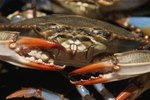
More than 100 species of king crabs inhabit taxonomic family Lithodidae. Three of the most familiar -- red (Paralithodes camtschaticus), blue (Paralithodes platypus) and golden king crabs (Lithodes aequispinus) -- are from Alaska. Among the largest in the world, crabs of these species regularly weigh around 10 pounds, though they can weigh up to 24 pounds.
Gangly Guys
These large crustaceans are known and prized for their long legs, the longest of which can reach almost 3 feet. King crabs have five pairs of legs. The first pair are pincers; the right pincer is the largest of all the legs. These claws serve the crabs when they need to capture food or fend off aggressors. The next three pairs get them around the ocean floor; the final pair tuck under their shells, or carapaces, and serve in mating. Like other crabs, king crabs must molt in order to grow. It’s normal for king crabs to molt up to 20 times in their lifetimes, including up to 10 times during their first year of life. These guys shed their hard shells multiple times a year until they’re sexually mature. Female king crabs must molt annually to mate; male crabs molt less frequently as they age, sometimes going three or more years between molts.
Starting Out and Going Under
Female adult king crabs carry their eggs about a year before they hatch. Like most other crabs, king crabs hatch from eggs that swim as shrimplike larvae, feeding on tiny organisms. Unlike most other crabs, king crabs go through a molting stage when they can't eat before they make their way to the sea's floor.
Soup's On
King crabs eat what they find on the sea's floor, including sea worms, clams, sand dollars, mussels, snails, sea urchins, barnacles and algae. Despite their large sizes, they are prey for other sea-dwellers, such as sea otters, octopuses and halibut -- and even their own kind. Of course, humans enjoy dining on these crustaceans. Fishermen value red king crabs, blue crab are known for their very large claws, and golden king crabs are the smallest of the three common Alaska king crabs.
Not Your Normal Crab
Red king crabs live in relatively shallow water, around 150 feet deep. Blue king crabs tend to hang out in water depths of around 600 feet. Golden crabs live in much deeper water, at depths between 600 and 2,400 feet, occasionally venturing down as deep as 3,000 feet. Despite the size difference, king crabs are similar to hermit crabs, their close relatives. Both have abdomens that are twisted to one side, and both have a large right claw. Because king crab legs fold backward instead of forward, the creatures can walk straight forward. Other crabs walk sideways.
References
- National Oceanic and Atmospheric Administration: Alaska Fisheries Science Center: Molting: How Crabs Grow
- National Oceanic and Atmospheric Administration: Adaptations of Crabs to Life in the Deep Sea
- Alaska Department of Fish and Game: Golden King Crab (Lithodes Aequispinus)
- Alaska Department of Fish and Game: Red King Crab (Paralithodes Camtschaticus)
- Alaska Department of Fish and Game: Blue King Crab (Paralithodes Platypus)
- Discovery: Deadliest Catch: Anatomy of an Alaskan King Crab
- Fact Zoo: King Crab - Alaskan Cold-Water Giants
- JuneauEmpire.com: Crabs in Depths are Different
Resources
Photo Credits
-
Comstock Images/Comstock/Getty Images



